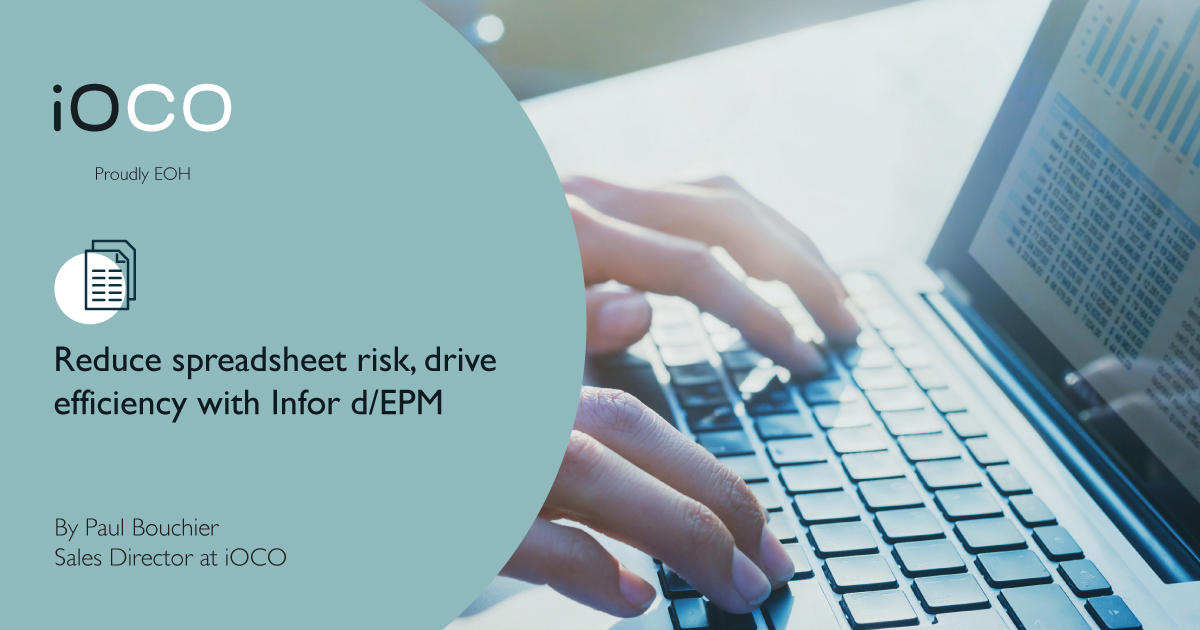By Paul Bouchier
Sales Director at iOCO, within iOCO Software Distribution, an Infor Gold Partner
Modernity demands that business leaders leverage data for better and more strategic decision-making. Unfortunately, in many cases analysts still choose to bypass the IT department and opt for spreadsheets. While spreadsheets are often the tool of choice to store, manage, analyse, arrange, and present information for financial planning, data analysis, compliance, and more – it is a hugely inefficient practice. Add to this the high risk of exposing confidential information and the need to transform the approach is evident.
The Love Hate Relationship with Spreadsheets
Users note 10 reasons why they love spreadsheets and are hesitant to effect a change:
- Free for end-users
- User control
- Easy to access
- Easy to use
- Easy to share
- Easy to edit
- Flexible
- User-defined formulas
- Range of utilities to manage and process data
- Programmable
However, Infor research shows that spreadsheets really do hurt organisations. Hidden within spreadsheets are several inherent risks.
- Cost formulas not repopulating correctly
- “Copy and paste” and merging records not done correctly
- Information hidden behind formatting
- Coworkers using different versions of a saved spreadsheet
- Actions that create errors, wasted time and low data quality
- Business decisions based on inaccurate data, negatively impacting productivity, revenue, reputation, compliance, and brand
Five Ways Modern Analytics Reduce Spreadsheet Risk and Inefficiency
1. Budgeting and Planning
d/EPM offers out-of-the-box budgeting, planning, and forecasting software to improve visibility into the financial process. It does this by connecting to an organisation’s core enterprise resource planning (ERP) system and collecting information to generate an overview of the budgets, plans, and actuals in just a few clicks.
2. Financial Consolidation
d/EPM simplifies the process of collecting, consolidating, and reporting accurately from operating units worldwide, while quickly delivering financial results to senior internal management and external stakeholders.
3. Business Intelligence and Analytics
d/EPM delivers fast time to value, enabling the business user to make data-driven decisions. Administrators, developers, and analysts no longer waste massive amounts of resources managing a reporting factory; they can rather reallocate resources to serve the business with more innovative analytic projects such as predictive and prescriptive analytics.
4. Customer and Supplier Communication
d/EPM offers out-of-the-box APIs to allow developers to embed analytics into an application, services, portals, and extranets seamlessly and securely. This enables customers and partners to gain direct access to real-time, trusted information, making it easier to collaborate and make strategic decisions together and on-demand without leaving the customer support application.
5. Auditing and Compliance
d/EPM’s modern data and analytics architecture offers risk and compliance software to support all types of internal and external audits, enabling finance, audit, and IT users to share a common platform to monitor controls across all their key applications independently. These platforms analyse user roles to proactively detect segregation of duties violations and potential issues in posted transactions and master data. Through automation, users consistently and actively manage multiple types of risk across the business to improve operational effectiveness and efficiency.
This is a compelling business case for retiring spreadsheets for good.
For more information about how to Infor d/EPM will drive efficiency, please contact Paul Bouchier at paul.bouchier@ioco.tech.



